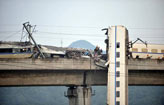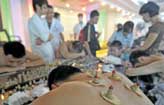Economy
It's not just child's play
Updated: 2011-07-29 12:19
By Xiao Xiangyi (China Daily European Weekly)
 |
|
Esben Joergensen, general manager of Lego China, says the company expects annual sales growth of 30 percent in China over the next few years. Xiao Xiangyi / China Daily |
Lego China builds its business brick by brick
For many people the brand Lego epitomizes imagination and creativity. It has twice been named Toy of the Century, by Fortune magazine and the British Association of Toys.
In recent years, the Danish brand has worked its way into China, a country often criticized for its lack of creative spirit, and the colorful bricks have worked their magic on the hearts of millions of Chinese.
Lego has been trying to woo the top 30 percent income earners in first-tier cities with its products, but now it is trying to widen its appeal.
According to the 2011 Toy Consumption Survey conducted by China Toy Association, Lego is among the top five toy brands in China, along with the domestic brand Audley, Hasbro and Mattel of the United States and Bendai of Japan.
However, a top brand name does not necessarily translate into a big piece of the pie in China's highly fragmented toy market, where price is upper most in the minds of the mass market consumer.
Toy sales in China reached $4.9 billion in 2009, making it the third-largest market after the US and Japan, according to a toy industry report by ResearchInChina, a market research company headquartered in Beijing. But average annual spending on toys for children was only $20, compared with $401 in Australia and $280 in the US. Figures for 2010 are unavailable.
"We want to stay a top brand in terms of brand strength, but also to have the biggest sales in the Chinese toy market," says Esben Joergensen, general manager of Lego China. "We want Lego to become a household brand in China, even in the second- and third-tier cities."
Lego has a history that goes back nearly 80 years, but the plastic bricks made their way into Chinese children's hands about 28 years ago, through agent dealers. The company's revenue in the Chinese market was approximately 1 percent of its global total by the beginning of last year. The company finally opened Lego China, with its office in Beijing, in June 2010, to operate in coordination with its Chinese agent, Kids Land Company.
The opening of Lego China has been accompanied by solid sales figures, with revenue growing 45 percent last year. A growth of 40 percent is forecast in 2011. The company has ambitious goal for the nine years to 2020: growing 30 percent a year.
The biggest challenge is the toy bricks' affordability and accessibility for consumers.
"Lego is more expensive in China mainly because of the retailing structure here," Joergensen says, "and actually it is a problem that many foreign brands are facing here in China."
Compared with Europe, the US or Japan, distribution of retailers in China is sparse, which means that Lego bricks tend to be in relatively low volume and relatively expensive.
"Because of the complexities of the Chinese retail structure, we will continue our cooperation with Kids Land Company for the foreseeable future," Joergensen says.
"If we don't, Lego will need to cover the marketing or transportation cost. For example, 40 percent of German households with children receive on average four Lego products every year. In China, we don't know, perhaps far from that. But for sure, Chinese consumers who have Lego products are as enthusiastic as those in Germany. China has the highest second purchase rate in Asia."
Lego Group has been working hard to put its bricks at the top of children's toy wish lists. Ads have run on TV, aimed at both children and their parents, and a more direct, tactile approach has been taken in holding events in which children can play with the bricks. Other media including twitter, Sina and Tencent weibo - the latter being two micro-blogging services - are being used to win over adults.
It is unusual for children's toys to transcend the realms of the young and cross over into the world of adults, but Lego is one of the exceptions. Perhaps the appeal to grown-ups lies in the almost boundless scope for creation that the blocks offer. It has been calculated that six eight-studded bricks could be combined in more than 102 million ways. Some of the world's most imaginative and brilliant minds are fans, such as Google co-founder Larry Page and Pixar Chief Creative Officer John Lasseter.
And even though Lego's target age group is two to 12, the bricks have a solid following in China among grown-ups, and there is even a band of supporters called AFOL, or Adult Fans of Lego.
A television series has also helped raise Lego's profile. The Story of Lele Town, a 25-episode stop motion animation with Lego bricks, was shown on Shanghai Oriental TV Haha Children's Channel. The series was made by a Lego fan, Zhou Qin, independent of the company, and with no appearances of the Lego logo.
Zhou also set up one of the most famous online forums for Chinese AFOL, which is also called "The Story of Lele Town". Those using the forum were polled on their ages, and of the 1,000 respondents 31.5 percent said they were between 24 and 30; about 29 percent said they were between 31 and 40; and 14.5 percent said they were between 19 and 23.
"I bought the first set of Lego bricks for my 3-year-old son, but now I am even more addicted to it than my kid," says Liu Jin, 33. "It brings nostalgia for when I was little."
Joergensen can relate to that. "Kids in China are busy with their studies, but adults may have more free time and money to become Lego players," he says. "For many adults it allows them the experience which they may have been denied in childhood."
Indeed, Lego's influence in China has gone far beyond the realm of toys. Lego programs of Serious Play are used by some companies to train employees to think in an abstract way, to brainstorm and to work with a team spirit. Lego has also initiated a program with the Chinese Ministry of Education offering educational facilities to secondary schools.
Lego's biggest competitor in China is the domestic Jumbo Grand, which has produced the Lego-like Banbao bricks since 2005. Their relatively low price has helped them gain part of the market share in China and overseas, and they have been exported to more than 100 countries. An aircraft carrier made of more than 6,500 Banbao bricks was a highlight at a toy fair in Nuremberg, Germany, in February.
Despite the fierce rivalry in China from the likes of Banbao, Joergensen is highly optimistic about the potential.
"I was very happy and proud to see so many children surrounding Lego bricks in those shopping malls," Joergensen says, recalling Children's Day this year, which happened to coincide with the anniversary of Lego China.
"I feel that I am selling something good, not like cigarettes. To play should not be seen as a waste of time, but a valuable experience in life."

Specials

Wen pledges 'open' probe
Design flaws in the signal equipment led to Saturday's fatal high-speed train collision, authorities say.

Turning up the heat
Traditional Chinese medicine using moxa, or mugwort herb, is once again becoming fashionable

Ciao, Yao
Yao Ming announced his retirement from basketball, staging an emotional end to a glorious career.